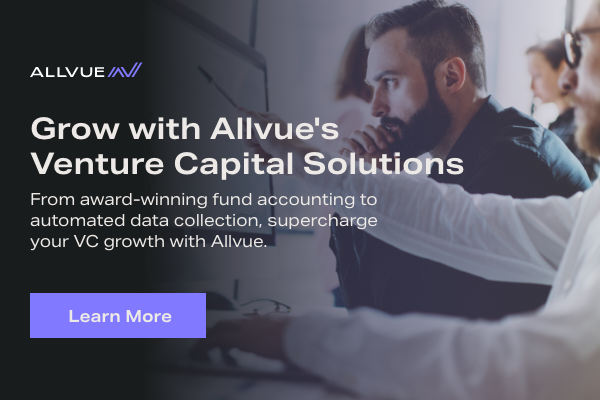
By: Michelle Wu
Head of Marketing
July 16, 2024
Venture capital is a form of financing that investors give to startups or young businesses with promising long-term growth potential.
These investors, who are collectively known as venture capitalists (VCs), provide the funds in exchange for an equity stake in the company of interest. The funding can be used for various purposes, such as developing products, expanding into new markets, hiring new talent, and scaling operations.
By investing in early-stage companies, VCs hope to get a significant return on their investment if the company achieves substantial growth and then goes public or is acquired by a larger company.
In this post we’ll discuss the ins and outs of venture capital, and how Allvue supports firms in the space.
How venture capital works
Venture capitalists typically invest in startups and small businesses through venture capital funds. These are professional investment entities that pool capital from wealthy individuals and institutions and then invest them in promising startups.
Multiple venture capital funds may exist within one venture capital firm — each focusing on a specific industry or stage of development. Startups that receive funding from a VC fund are referred to as portfolio companies.
VC funds are usually structured as partnerships composed of two main players; general partners (GPs) and limited partners (LPs).
GPs are the fund’s managers. Many often have a background or experience in corporate finance or relevant industries aligned with the fund’s focus. They play an active role in the companies their funds invest in, providing strategic guidance, network connections, and assistance in navigating challenges, with the ultimate goal of helping the companies succeed.
Limited partners (LPs) are the investors who contribute capital for investment. They are usually wealthy individuals and institutional investors like banks, family offices, university endowments, pension funds, and insurance companies. LPs are generally not involved in managing the fund but expect regular updates on its performance from the GPs.
Both the GPs and LPs share in the fund’s profits. The typical split is 20% for GPs and 80% for LPs. Additionally, GPs often receive an annual management fee of about 2% of the total capital invested.
The venture capital investment process
A venture capital investment usually passes through four stages. Let’s break each stage down.
Raising capital
The first stage in establishing a venture capital fund involves raising capital from limited partners, which again includes wealthy individuals and institutional investors.
During the fundraising process, the VC firm outlines its investment strategy, target returns it aims to deliver for investors, and fees associated with managing the fund. Once sufficient capital is raised, the VC firm can begin searching for promising startups for investment.
Deal sourcing
This is the stage where the venture capitalists find, evaluate, and screen potential investment opportunities. VC funds usually employ a multifaceted approach to deal sourcing. This might include:
- Collaborating with startup accelerators and incubators that nurture early-stage ventures.
- Networking with other investors, especially institutional firms to increase deal flow.
- Tapping existing portfolio companies, industry experts and entrepreneurs and other referral sources for warm inbound leads
- Using online platforms and databases to discover startups with high-growth potential.
Due diligence
Once the fund identifies a potential investment, it conducts thorough due diligence. This in-depth evaluation involves assessing various aspects of the startup, including growth potential, product market fit, financials, business model, competitive landscape, legal and regulatory compliance, and experience and capabilities of the management team.
Thorough VC due diligence helps identify risks and potential opportunities associated with the investment. This ensures the VC firm is investing in a company with a solid foundation for growth.
Negotiation and investment
If the due diligence is satisfactory, a VC fund or firm and startup then negotiate to define the terms of the investment. These terms are typically outlined in a legal document called a term sheet which is the blueprint for the investment.
Key points covered in the term sheet include the total investment amount, the ownership stake (equity) received by the VC firm, and other crucial conditions such as board representation. The VC fund then provides the agreed-upon funds to the startup, and it gets an equity position in return. A term sheet is also the basis for more legally binding documents, such as a Stock Purchase Agreement and Voting Agreement.
Value creation and post-investment support
Following the investment, GPs work closely with the startup to accelerate growth and generate value. They can join the board of directors and actively contribute to strategic decision-making, offer operational advice, provide mentorship, and help the company with networking and even additional fundraising.
Exit
VCs usually have an exit plan when investing in startups. An exit, which typically occurs eight to ten years after the first investment, is how VCs realize a return on their investment. The main exit options are an initial public offering (IPO), where the company’s shares are sold to the public, or an acquisition by a larger corporation.
The venture capital lifecycle
Venture capital is typically provided in several stages, starting with seed funding and then progressing to other subsequent rounds as the company grows. Each subsequent financing round usually involves a larger investment amount as the firm achieves certain milestones and demonstrates its growth potential.
Here’s a breakdown of the common funding stages.
- Angel or pre-seed funding: This stage typically involves self funding, or funding by family and friends and involves developing a business concept, securing patents, drafting partnership contracts, and creating pitchbooks.
- Seed funding: This is the earliest stage of venture capital, where investors provide a startup with investment capital to create a product or enhance the product, make very early key hires, and engage in a larger round of fundraising.
- Early-stage funding: Once the startup has developed a product, launched it, and gained some market traction, early-stage funding comes into play. This consists of a couple of funding rounds known as Series A and Series B, which provide capital to scale the business. The company can use the funds to expand its team, ramp up marketing efforts, and enhance the product based on user feedback.
- Late-stage funding: At this stage, the company has achieved significant growth and established a solid market position. Late-stage funding rounds, like Series C and D, are then used to fuel further expansion and push the company towards market leadership.

The benefits and risks of venture capital
Venture capital offers a compelling funding option for startups, but it also comes with certain challenges and risks. Understanding these benefits and risks can help entrepreneurs decide whether to seek venture capital or explore alternative types of funding.
Benefits
- Access to capital: This is perhaps the most obvious advantage of venture capital. It provides startups with the financial resources they need to develop their products or services, hire talent, and pursue growth opportunities. Unlike many other types of funding like bank loans, venture capital doesn’t require repayment — VCs get their money back when the company eventually goes public or is acquired.
- Mentorship and guidance: Venture capitalists (VCs) are often seasoned pros with a wealth of knowledge and expertise. They can provide valuable mentorship and guidance to startup founders, and assist them navigate the challenges of growing a young company.
- Industry connections: VCs typically have a strong network of contacts within their respective industries or focus areas. They can use these connections to help startups gain access to potential customers, partners, and other resources that can accelerate growth.
- Validation: If you are a founder, securing funding from well-respected investors lends credibility to your enterprise. Venture capitalists are selective and only invest in startups with high growth potential. This validation can enhance a firm’s marketability and make it easier to attract customers, recruit talent, and even secure additional funding.
Challenges
- Loss of control: When firms take in venture capital, they relinquish some ownership and control of the company. In some cases, VCs might ask for a seat on the board of directors or may have a say in major decisions such as product development, marketing strategies, and hiring.
- Pressure to deliver rapid growth: Venture capital firms are looking for high returns on their investments. This can put significant pressure on startups to achieve rapid growth and meet aggressive financial targets.
- Dilution of shares: As a startup raises additional funding rounds, the ownership stake of the founders can become diluted. This means they own a smaller percentage of the company, potentially reducing their profits upon a successful exit.
- Time requirements: Venture capitalists require regular updates on the startup’s performance. This can involve presenting financial reports, meeting with investors, and providing detailed metrics on progress toward goals. These reporting demands can be time-consuming and detract from core business activities. What’s more, the venture capital fundraising process itself can be lengthy, requiring significant time investment and that could otherwise be dedicated to building the business.
For venture capital funds and other institutional investors, there are also risks and rewards to this type of private equity investing.
Rewards
- High returns: Successful venture capital investments can generate significantly higher returns for investors if the companies they invest in go on to be successful.
- Portfolio diversification: Venture capital can be a valuable tool for diversifying an investment portfolio. Since venture capital investments are not highly correlated with traditional asset classes.
- Access to innovative companies: Venture capital allows investors to gain access and exposure to innovative companies at the forefront of technological advancements and industry disruption.
Risks and challenges
- Deal flow: Finding promising startups with high growth potential can be challenging. Venture capitalists must have a strong network to ensure high quality deal flow to ensure their investments are high quality.
- High startup failure rate: Startups are inherently risky ventures. A significant percentage fail to achieve their full potential, and investors may lose their entire investment.
- Uncertain Return Period: Venture capital investments typically don’t have a standard return period, and it can be hard to predict when an investment will pay off.
Venture capital exit strategies
There are typically two main ways for a venture capital fund to exit an investment.
Initial Public Offering (IPO)
An IPO is one of the most desirable outcomes for venture-backed startups. It involves offering shares of the company to the public through a stock exchange. Successful IPOs can provide substantial returns for both the company’s founders and its investors. However, the IPO process is complex and subject to stringent regulatory requirements. It can also incur high costs.
Acquisition
A VC-backed company can also be acquired by another company. This can be a strategic acquisition where the acquirer wants to gain access to the startup’s technology or talent. For example, a large tech company might acquire a promising artificial intelligence (AI) startup to bolster its own AI capabilities.
Alternatively, it could be a financial acquisition where the acquirer is primarily interested in the startup’s assets or customer base. Acquisitions provide VC firms with a potentially quicker and more predictable exit compared to an IPO.
Case studies of notable venture capital successes and failures
The venture capital industry boasts numerous success stories where investments have yielded significant returns for VCs. Here are a few top examples:
- Kleiner Perkins and Google: Kleiner Perkins invested $12.5 million in Google in 1999 during its early stages. Google went public in 2004 with a valuation of $23 billion. This translated to a return of approximately 300x for Kleiner Perkins, or $4.3 billion on their investment.
- Benchmark and eBay: Benchmark Capital invested $6.7 million in eBay in 1995. When eBay went public in 1998, it was valued at around $1.9 billion. Benchmark’s investment saw a remarkable 750x return in just two years.
- Accel and Facebook: Accel invested $12.7 million in Facebook in 2005. When Facebook went public in 2012, it was valued at over $104 billion. This growth translated to a 700x return for Accel, tuning their initial investment into a staggering $9 billion.
- Sequoia and WhatsApp: Sequoia Capital invested $60 million in WhatsApp across multiple rounds. In 2014, Facebook acquired WhatsApp for $22 billion. This acquisition provided Sequoia with an estimated 50x return on their investment, turning their $60 million into nearly $3 billion
Not all venture-backed startups succeed, unfortunately. Many fail to achieve product-market fit, run out of capital, or cannot scale their operations effectively, leading to shutdowns and losses for the venture capitalists who invested in them.
Here are two notable examples of venture capital failures.
- Quibi (Failure): Quibi, a mobile-first short-form streaming service launched in 2020 with about $1.75 billion in funding from major media companies and tech giants. However, Quibi failed to gain traction in a crowded streaming market and shut down just six months after launch.
- Theranos: Theranos, a health technology company, raised over $700 million from prominent venture capitalists and private investors, claiming to revolutionize blood testing. After the technology was later exposed as flawed, the company faced regulatory and legal challenges, eventually leading to its dissolution in 2018.
Wrapping Up: Venture capital’s Future and Allvue’s role
As we look to the future, venture capital is expected to continue playing an important role in the private equity world. In fact, according to Statista, the total capital raised globally in this venture capital market is expected to reach US$468.4bn in 2024.
Emerging trends in venture capital that could be worth keeping an eye on include increased focus on social impact investing and sustainability and the rise of new and disruptive technologies like artificial intelligence(AI) and the blockchain.
Allvue Systems stands as a vital partner for venture capital funds and firms, providing the tools and support they need to effectively navigate this dynamic landscape.
With solutions for elements like fund accounting, portfolio motoring, and investor relations management, Allvue venture capital software empowers VC funds to manage investments effectively, make data-driven decisions, and ultimately achieve superior outcomes for their investors.
Request a free demo today to see how easy and seamless venture capital investing can be with Allvue.
Sources
CB Insights: The 45 Best VC Investments Of All Time and What to Learn From Them. https://www.cbinsights.com/research/report/best-venture-capital-investments/
Startups.com. Series A, B, C, D, and E Funding: How It Works/. https://www.startups.com/library/expert-advice/series-funding-a-b-c-d-e
Statista. Venture Capital-Worldwide. https://www.statista.com/outlook/fmo/capital-raising/traditional-capital-raising/venture-capital/worldwide#global-comparison
More About The Author

Michelle Wu
Head of Marketing
Michelle is a dynamic marketing leader with 15+ years of experience in capital markets, fintech, and cybersecurity technology industries. Prior to joining Allvue, Michelle was the Vice President of Product Marketing at SecurityScorecard, a global leader in cybersecurity ratings, and was the Head of Security & Compliance Marketing at Box. Before moving into cybersecurity, she led the Banking & Securities GTM strategy at Intralinks and covered capital markets clients at HSBC. She holds an MSc in Media & Communications from the London School of Economics and a BS in Marketing & Finance from NYU Stern School of Business.



